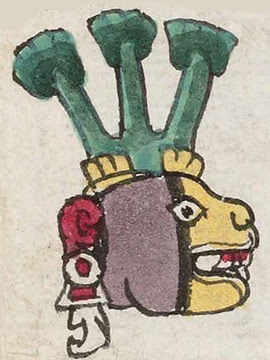Xonoctla (Mdz51r)
This compound glyph for the place name Xonoctlan has two principal elements. At the top are three trunks or branches representing the xonotl) tree. The multicolored, anthropomorphized, dog-like head below the tree appears to be a phonetic reinforcement, intending to elicit the divine force or deity name, Xolotl, a near homophone. The locative suffix (-tla, -tlah, or -tlan, if the final "n" has been inadvertently dropped) is not shown visually. Representations of Xolotl often have sharp teeth and wrinkled faces, recalling the xoloitzcuintli, native Mexican dog.
Stephanie Wood
One wonders whether the "c" in Xonoctla should be there, if the place name is mainly intending to speak of a place known for the xonotl tree. Sometimes the spelling is Xonotla. See The Essential Codex Mendoza, eds. Frances F. Berdan and Patricia Rieff Anawalt, 1997, p. 128.
In this digital collection, face paint or tattooing has ethnic associations, involving Chichimecs, the Otomí, the Tlaxcalteca, and those who were “different” (e.g. the Tlamaca or Tlamanca). Divine forces, such as Ecatl (or Ehecatl) and Xolotl, also have some face paint or tattoos.
Stephanie Wood
xonoctla. puo
Xonoctla, pueblo
Stephanie Wood
c. 1541, or by 1553 at the latest
Stephanie Wood
trees, árboles, deities, deidades, dogs, perros, nombres de lugares
This photo of the xoloitzcuintli is hosted by Flickr, and Google marks it as having Creative Commons rights.

xono(tl), a type of tree, https://nahuatl.wired-humanities.org/content/xonotl
Xolo(tl), god of lightning and death, typically depicted as a dog-headed man, https://nahuatl.wired-humanities.org/content/Xolotl
xoloitzcuin(tli), a native Mexican (almost) hairless dog, https://nahuatl.wired-humanities.org/content/xoloitzcuintli
-tla (locative suffix), place of abundance of, https://nahuatl.wired-humanities.org/content/tla-1
-tlan (locative suffix), place, https://nahuatl.wired-humanities.org/content/tlan
Codex Mendoza, folio 51 recto, https://digital.bodleian.ox.ac.uk/objects/2fea788e-2aa2-4f08-b6d9-648c00..., image 112 of 118.
The Bodleian Libraries, University of Oxford, hold the original manuscript, the MS. Arch. Selden. A. 1. This image is published here under the UK Creative Commons, “Attribution-NonCommercial-ShareAlike 3.0 License” (CC-BY-NC-SA 3.0).




